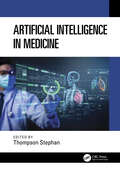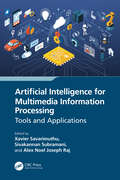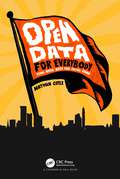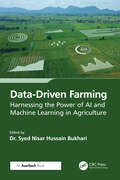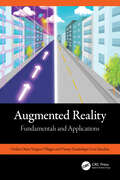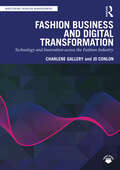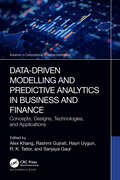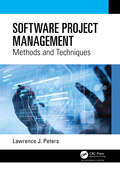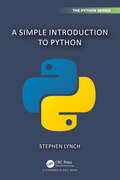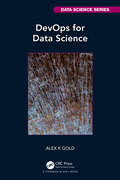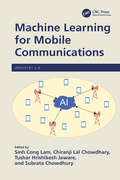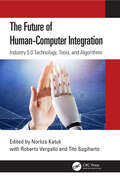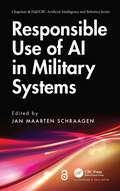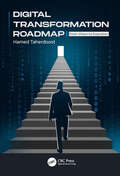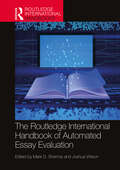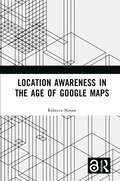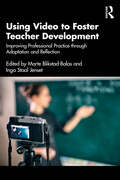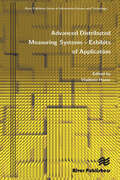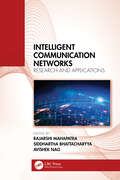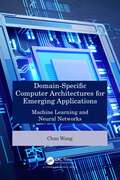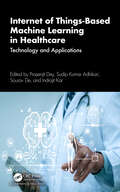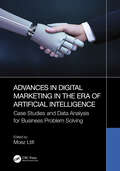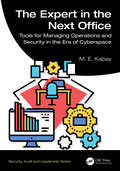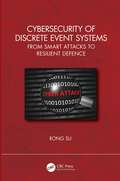- Table View
- List View
Artificial Intelligence in Medicine
by Thompson StephanIn the ever-evolving realm of healthcare, Artificial Intelligence in Medicine emerges as a trailblazing guide, offering an extensive exploration of the transformative power of Artificial Intelligence (AI). Crafted by leading experts in the field, this book sets out to bridge the gap between theoretical understanding and practical application, presenting a comprehensive journey through the foundational principles, cutting-edge applications, and the potential impact of AI in the medical landscape.This book embarks on a journey from foundational principles to advanced applications, presenting a holistic perspective on the integration of AI into diverse aspects of medicine. With a clear aim to cater to both researchers and practitioners, the scope extends from fundamental AI techniques to their innovative applications in disease detection, prediction, and patient care.Distinguished by its practical orientation, each chapter presents actionable workflows, making theoretical concepts directly applicable to real-world medical scenarios. This unique approach sets the book apart, making it an invaluable resource for learners and practitioners alike.Key Features:• Comprehensive Exploration: From deep learning approaches for cardiac arrhythmia to advanced algorithms for ocular disease detection, the book provides an in-depth exploration of critical topics, ensuring a thorough understanding of AI in medicine.• Cutting-Edge Applications: The book delves into cutting-edge applications, including a vision transformer-based approach for brain tumor detection, early diagnosis of skin cancer, and a deep learning-based model for early detection of COVID-19 using chest X-ray images.• Practical Insights: Practical workflows and demonstrations guide readers through the application of AI techniques in real-world medical scenarios, offering insights that transcend theoretical boundaries.This book caters to researchers, practitioners, and students in medicine, computer science, and healthcare technology. With a focus on practical applications, this book is an essential guide for navigating the dynamic intersection of AI and medicine. Whether you are an expert or a newcomer to the field, this comprehensive volume provides a roadmap to the revolutionary impact of AI on the future of healthcare.
Artificial Intelligence for Multimedia Information Processing: Tools and Applications
by Xavier Savarimuthu Sivakannan Subramani Alex Noel Joseph RajAdvances in artificial intelligence (AI), widespread mobile devices, internet technologies, multimedia data sources, and information processing have led to the emergence of multimedia processing. Multimedia processing is the application of signal processing tools to multimedia data—text, audio, images, and video—to allow the interpretation of these data, particularly in urban and smart city environments. This book discusses the new standards of multimedia and information processing from several technological perspectives, including analytics empowered by AI, streaming on the intelligent edge, multimedia edge caching and AI, services for edge AI, and hardware and devices for multimedia on edge intelligence.FEATURES Covers a wide spectrum of enabling technologies for AI and machine learning for multimedia and information processing Includes many applications using AI, from robotics and driverless cars to environmental, human health, and remote sensing Presents an overview of the fundamentals of AI and multimedia processing: imaging, signal, and speech Explains new models and architectures for multimedia streaming, services, and caching for AI Discusses the emerging paradigms of the deployment of hardware and devices for multimedia on edge intelligence Gives recommendations for future research in multimedia and AI This book is written for engineers and graduate students in image and signal processing, information processing, environmental engineering, medical and public health, etc., who are interested in machine learning, deep learning, and multimedia processing.
Open Data for Everybody: Using Open Data for Social Good
by Nathan CoyleWhat if I told you something that could empower our third sector and activists to enhance their capacity? From gathering evidence for funding tenders to campaigning for crucial social issues and much more? It's called open data, yet many in social action remain unaware of it. Primarily shaped by corporate entities, open data seems tailored only for technologists, alienating the third sector. But in reality, it's a powerful tool for social change, bolstering civil society, and creating resilient communities.This book argues a simple point: if open data and the digital aspects that support it aren't accessible to all, then what is the point of it? In an age where technology should be seen as a fundamental human right, it's time to rethink outreach. Deeply rooted in grassroots social activism, this book explores a journey that led to collaborations with governments globally, based on real hands-on work, aiming to democratize open data. Through narrative storytelling, we share insights, best practices, procedures, and community-driven approaches. Regardless of your skill set or organization size, from grassroots workers to third-sector professionals and government officers, join us to reshape the perception of open data, fostering change in neighborhoods.Open Data for Everybody: Using Open Data for Social Good is a love letter to open data's transformative power. To create solutions, understanding the problem is crucial. This book seeks to return control to the real experts—those living and working within our communities.
Data-Driven Farming: Harnessing the Power of AI and Machine Learning in Agriculture
by Syed Nisar Hussain BukhariIn the dynamic realm of agriculture, artificial intelligence (AI) and machine learning (ML) emerge as catalysts for unprecedented transformation and growth. The emergence of big data, Internet of Things (IoT) sensors, and advanced analytics has opened up new possibilities for farmers to collect and analyze data in real-time, make informed decisions, and increase efficiency. AI and ML are key enablers of data-driven farming, allowing farmers to use algorithms and predictive models to gain insights into crop health, soil quality, weather patterns, and more. Agriculture is an industry that is deeply rooted in tradition, but the landscape is rapidly changing with the emergence of new technologies.Data-Driven Farming: Harnessing the Power of AI and Machine Learning in Agriculture is a comprehensive guide that explores how the latest advances in technology can help farmers make better decisions and maximize yields. It offers a detailed overview of the intersection of data, AI, and ML in agriculture and offers real-world examples and case studies that demonstrate how these tools can help farmers improve efficiency, reduce waste, and increase profitability. Exploring how AI and ML can be used to achieve sustainable and profitable farming practices, the book provides an introduction to the basics of data-driven farming, including an overview of the key concepts, tools, and technologies. It also discusses the challenges and opportunities facing farmers in today’s data-driven landscape. Covering such topics as crop monitoring, weather forecasting, pest management, and soil health management, the book focuses on analyzing data, predicting outcomes, and optimizing decision-making in a range of agricultural contexts.
Augmented Reality: Fundamentals and Applications
by Osslan Osiris Vergara Villegas Vianey Guadalupe Cruz SánchezThis book focuses on augmented reality (AR) technology, which uses the real environment to superimpose virtual elements. Therefore, the reader can create applications that simulate scenarios that can be dangerous or expensive to generate in the real world. AR has proven helpful in education, marketing, and industrial scenarios. AR technology improves the user experience of various disciplines, incorporating virtual information that maximizes the experience and adds knowledge. This book intends students, researchers, and developers to have the possibility of finding the foundations on which AR technology rests.Our book intends that students, researchers, and developers: (i) learn the basics of AR; (ii) understand the technologies that support AR; (iii) know about AR applications that have been a watershed; (iv) gain an understanding of the critical elements needed to implement an AR application; (v) acquire skill in the step-by-step development of an AR application; (vi) learn how to use the instruments to evaluate an AR application; (vii) understand how to present the information about study cases; and (viii) gain knowledge about AR challenges and trends.
Fashion Business and Digital Transformation: Technology and Innovation across the Fashion Industry (Mastering Fashion Management)
by Charlene Gallery Jo ConlonFashion Business and Digital Transformation provides a practical and holistic overview of the fashion industry and the key technologies impacting the fashion supply chain. It covers product design and development, production, sales and customer experiences in physical, online and virtual environments. The key technologies impacting the ecosystem are explored, including artificial intelligence, virtual reality, augmented reality, digital fashion design, NFTs, 3D textiles, and blockchain. Strategic concepts such as ‘retail-tainment’, ‘phygital’, gamification and e-commerce, are analysed, alongside the effect of these key strategies for both the retailer and the customer.Theoretical foundations are supported by extensive use of examples, interviews and case studies drawn from a wide range of global fashion disrupters and cutting-edge brands. Engaging activities, exercises, and technical step-by-step guides are incorporated throughout, which will both consolidate how technology is driving change in the industry, but also equip the reader with the key skills and digital literacy capabilities required by future practitioners. Online resources include chapter-by-chapter PowerPoint slides, a test bank and links to further resources.This examination of the digital transformation of the fashion industry will be essential reading for advanced undergraduate and postgraduate students of Fashion Management, Fashion Business and Fashion Technology.
Data-Driven Modelling and Predictive Analytics in Business and Finance: Concepts, Designs, Technologies, and Applications (Advances in Computational Collective Intelligence)
by Alex Khang Rashmi Gujrati Hayri Uygun R. K. Tailor Sanjaya Singh GaurData-driven and AI-aided applications are next-generation technologies that can be used to visualize and realize intelligent transactions in finance, banking, and business. These transactions will be enabled by powerful data-driven solutions, IoT technologies, AI-aided techniques, data analytics, and visualization tools. To implement these solutions, frameworks will be needed to support human control of intelligent computing and modern business systems. The power and consistency of data-driven competencies are a critical challenge, and so is developing explainable AI (XAI) to make data-driven transactions transparent.Data- Driven Modelling and Predictive Analytics in Business and Finance covers the need for intelligent business solutions and applications. Explaining how business applications use algorithms and models to bring out the desired results, the book covers: Data-driven modelling Predictive analytics Data analytics and visualization tools AI-aided applications Cybersecurity techniques Cloud computing IoT-enabled systems for developing smart financial systems This book was written for business analysts, financial analysts, scholars, researchers, academics, professionals, and students so they may be able to share and contribute new ideas, methodologies, technologies, approaches, models, frameworks, theories, and practices.
Software Project Management: Methods and Techniques
by Lawrence J. PetersThe management of a software project has been shown to be the number one factor in determining a software development project’s success. It has been found that most software projects fail because of poor management. Not surprisingly, most software development managers have not been trained in project management. Software Project Management: Methods and Techniques aims to remedy this situation in two ways: familiarizing software developers with the elements of the project management discipline and providing fact-based resources on practicing software project management.Much like the checklist pilots go through prior to a flight, this book provides a pre-project checklist which enables the software engineering team to review and evaluate an extensive set of technical and sociopolitical risks which will help the software project manager and the team determine the project team’s chances of success. This same list and the individual question responses can be used later as part of the project’s closeout process helping team members to improve their individual and collective abilities to assess risk.Intended for both students and software project managers, the book is organized along the lines of the five major functions of a software project manager: planning; scheduling and costing; controlling; staffing; and motivating. The basics of each of these functions are presented in a single chapter. These are followed by a series of narrow topic presentations in the form of appendices that are intended to help solve specific problems that may occur during the conduct of a software project. As in the main portion of the text, the appendices include references that provide an avenue into further detail on the topic. Designed to promote project success, this approach has been taken because software projects are each unique undertakings such that providing a "one size fits all" approach will fail most of the time.
A Simple Introduction to Python (Chapman & Hall/CRC The Python Series)
by Stephen LynchA Simple Introduction to Python is aimed at pre-university students and complete novices to programming. The whole book has been created using Jupyter notebooks. After introducing Python as a powerful calculator, simple programming constructs are covered, and the NumPy, MatPlotLib and SymPy modules (libraries) are introduced. Python is then used for Mathematics, Cryptography, Artificial Intelligence, Data Science and Object Oriented Programming.The reader is shown how to program using the integrated development environments: Python IDLE, Spyder, Jupyter notebooks, and through cloud computing with Google Colab.Features: No prior experience in programming is required. Demonstrates how to format Jupyter notebooks for publication on the Web. Full solutions to exercises are available as a Jupyter notebook on the Web. All Jupyter notebook solution files can be downloaded through GitHub. GitHub Repository of Data Files and a Jupyter Solution notebook: https://github.com/proflynch/A-Simple-Introduction-to-PythonJupyter Solution notebook web page: https://drstephenlynch.github.io/webpages/A-Simple-Introduction-to-Python-Solutions.html
DevOps for Data Science (Chapman & Hall/CRC Data Science Series)
by Alex GoldData Scientists are experts at analyzing, modelling and visualizing data but, at one point or another, have all encountered difficulties in collaborating with or delivering their work to the people and systems that matter. Born out of the agile software movement, DevOps is a set of practices, principles and tools that help software engineers reliably deploy work to production. This book takes the lessons of DevOps and aplies them to creating and delivering production-grade data science projects in Python and R.This book’s first section explores how to build data science projects that deploy to production with no frills or fuss. Its second section covers the rudiments of administering a server, including Linux, application, and network administration before concluding with a demystification of the concerns of enterprise IT/Administration in its final section, making it possible for data scientists to communicate and collaborate with their organization’s security, networking, and administration teams.Key Features:• Start-to-finish labs take readers through creating projects that meet DevOps best practices and creating a server-based environment to work on and deploy them.• Provides an appendix of cheatsheets so that readers will never be without the reference they need to remember a Git, Docker, or Command Line command.• Distills what a data scientist needs to know about Docker, APIs, CI/CD, Linux, DNS, SSL, HTTP, Auth, and more.• Written specifically to address the concern of a data scientist who wants to take their Python or R work to production.There are countless books on creating data science work that is correct. This book, on the otherhand, aims to go beyond this, targeted at data scientists who want their work to be than merely accurate and deliver work that matters.
Machine Learning for Mobile Communications (Industry 5.0)
by Chiranji Lal Chowdhary Subrata Chowdhury Sinh Cong Lam Tushar Hrishikesh JawareMachine Learning for Mobile Communications will take readers on a journey from basic to advanced knowledge about mobile communications and machine learning. For learners at the basic level, this book volume discusses a wide range of mobile communications topics from the system level, such as system design and optimization, to the user level, such as power control and resource allocation. The authors also review state-of-the-art machine learning, one of the biggest emerging trends in both academia and industry. For learners at the advanced level, this book discusses solutions for long-term problems with future mobile communications such as resource allocation, security, power control, and spectral efficiency. The book brings together some of the top mobile communications and machine learning experts throughout the world, who contributed their knowledge and experience regarding system design and optimization.This book: Discusses the 5G new radio system design and architecture as specified in 3GPP documents Highlights the challenges including security and privacy, energy, and spectrum efficiency from the perspective of 5G new radio systems Identifies both theoretical and practical problems that can occur in mobile communication systems Covers machine learning techniques such as autoencoder and Q-learning in a comprehensive manner Explores how to apply machine learning techniques to mobile systems to solve modern problems This book is for senior undergraduate and graduate students and academic researchers in the fields of electrical engineering, electronics and communication engineering, and computer engineering.
The Future of Human-Computer Integration: Industry 5.0 Technology, Tools, and Algorithms
by Norliza Katuk Roberto Vergallo Tito SugihartoThe Future of Human-Computer Integration: Industry 5.0 Technology, Tools, and Algorithms provides a valuable insight into how Industry 5.0 technologies, tools, and algorithms can revolutionise industries and drive innovation.By emphasising the convergence of computer technology and human interaction, readers will learn the concepts of Industry 5.0, from the fundamentals to advanced techniques, with real-world examples and case studies in different industry sectors. The authors equip readers with the knowledge to mitigate risks to ensure success in this complex human and computer synchronisation in the era of Industry 5.0. This collection of writings by experts in their respective fields invites readers to journey through the transition from Industry 4.0 to Industry 5.0. Practical insights are offered alongside cutting-edge applications, such as blockchain, the Internet of Things (IoT), QR code, and augmented reality (AR), as well as the consideration of privacy, trust, and authentication through digital signatures. Such technologies and applications hold much promise to revolutionise industries and drive innovation.Topics in this book include the role of AI in human-computer interaction, efficient asset management using blockchain, computational thinking in program development, synergy of 5G and IoT in healthcare services, advances in increasing data capacity of QR codes, and personalised user experience with augmented reality. The authors also consider the challenges, risks, and concerns of such technologies and their applications in Industry 5.0. This book comprehensively explores Industry 5.0 from a computer science perspective as it delves into the technology aspects and tools for Industry 5.0. It offers readers a detailed understanding of how computer science intersects with Industry 5.0, how to humanise it, and its application to industry.This book has been written for technology professionals and practitioners, especially ones in healthcare, smart systems, and the oil and gas sectors. It will serve as a useful reference for students studying such advanced courses as digital technology, digital transformation, emergent technologies, and innovation through new technologies.
Emerging Digital Technologies and India’s Security Sector: AI, Blockchain, and Quantum Communications
by Pankaj K Jha Vedant Saigal Arun Teja PolcumpallyThis book is an introductory account for policy makers, academia, and interested readers on the digital technologies on Indian Military. It covers three technologies – AI, Blockchain, and Quantum communications – and provides a detailed account on the military use cases. It evaluates the readiness of Indian Military in these technologies. A foundational text, it not only provides key policy analysis but also identifies the gray areas for the future research in the security studies.The volume will be essential reading for scholars and researchers of military and strategic studies, especially future warfare, AI and Blockchain, and South Asian studies. It will be of interest to general readers as well.
Responsible Use of AI in Military Systems (Chapman & Hall/CRC Artificial Intelligence and Robotics Series)
by Jan Maarten SchraagenArtificial Intelligence (AI) is widely used in society today. The (mis)use of biased data sets in machine learning applications is well‑known, resulting in discrimination and exclusion of citizens. Another example is the use of non‑transparent algorithms that can’t explain themselves to users, resulting in the AI not being trusted and therefore not being used when it might be beneficial to use it.Responsible Use of AI in Military Systems lays out what is required to develop and use AI in military systems in a responsible manner. Current developments in the emerging field of Responsible AI as applied to military systems in general (not merely weapons systems) are discussed. The book takes a broad and transdisciplinary scope by including contributions from the fields of philosophy, law, human factors, AI, systems engineering, and policy development.Divided into five sections, Section I covers various practical models and approaches to implementing military AI responsibly; Section II focuses on liability and accountability of individuals and states; Section III deals with human control in human‑AI military teams; Section IV addresses policy aspects such as multilateral security negotiations; and Section V focuses on ‘autonomy’ and ‘meaningful human control’ in weapons systems.Key Features: Takes a broad transdisciplinary approach to responsible AI Examines military systems in the broad sense of the word Focuses on the practical development and use of responsible AI Presents a coherent set of chapters, as all authors spent two days discussing each other’s work This book provides the reader with a broad overview of all relevant aspects involved with the responsible development, deployment and use of AI in military systems. It stresses both the advantages of AI as well as the potential downsides of including AI in military systems.
Digital Transformation Roadmap: From Vision to Execution
by Hamed TaherdoostIn a world undergoing rapid technological evolution, this is your indispensable guide to thriving in the digital age. Digital Transformation Roadmap: From Vision to Execution offers a comprehensive exploration of the Fourth Industrial Revolution by presenting a roadmap for leveraging technology to revolutionize businesses, strategy, and innovation.Embark on a journey that unveils the dynamic interplay between technology and business. Discover the evolution of tech life cycles, the significance of digital transformation, and the key domains of change reshaping industries. Explore strategies to gain competitive advantage, from reimagining business models to aligning digital visions with organizational goals. Experience a holistic approach to digital transformation.Learn how to empower employees, foster a culture of innovation, and navigate change adeptly. Delve into the world of emerging technologies such as AI, IoT, and blockchain, and harness their potential to open new avenues for growth.From cybersecurity roadmaps to measuring system performance, uncover essential practices to ensure the resilience and success of digital initiatives. Master the art of delivering exceptional digital customer experiences and harnessing the value of data.Whether you’re a business leader, strategist, or tech enthusiast, this book equips you with actionable insights, practical strategies, and a forward-thinking mindset to drive change and thrive in the digital landscape.
The Routledge International Handbook of Automated Essay Evaluation (Routledge International Handbooks)
by Joshua Wilson Mark D. ShermisThe Routledge International Handbook of Automated Essay Evaluation (AEE) is a definitive guide at the intersection of automation, artificial intelligence, and education. This volume encapsulates the ongoing advancement of AEE, reflecting its application in both large-scale and classroom-based assessments to support teaching and learning endeavors.It presents a comprehensive overview of AEE's current applications, including its extension into reading, speech, mathematics, and writing research; modern automated feedback systems; critical issues in automated evaluation such as psychometrics, fairness, bias, transparency, and validity; and the technological innovations that fuel current and future developments in this field. As AEE approaches a tipping point of global implementation, this Handbook stands as an essential resource, advocating for the conscientious adoption of AEE tools to enhance educational practices ethically. The Handbook will benefit readers by equipping them with the knowledge to thoughtfully integrate AEE, thereby enriching educational assessment, teaching, and learning worldwide.Aimed at researchers, educators, AEE developers, and policymakers, the Handbook is poised not only to chart the current landscape but also to stimulate scholarly discourse, define and inform best practices, and propel and guide future innovations.
Location Awareness in the Age of Google Maps
by Rebecca NooneLocation Awareness in the Age of Google Maps explores the mundane act of navigating cities in the age of digital mapping infrastructures.Noone follows the frictions routing through Google Maps’ categorising and classifying of spatial information. Complicating the assumption that digital maps distort a sense of direction, Noone argues that Google Maps’ location awareness does more than just organise and orient a representation of space—it also organises and orients imaginaries of publicness, selfsufficiency, legibility, and error. At the same time, Location Awareness in the Age of Google Maps helps to animate the ordinary ways people are challenging and refusing Google Maps’ vision of the world. Drawing on an arts-based field study spanning the streets of London, New York, London, Toronto, and Amsterdam, Noone’s encounters of "asking for directions" open up lines of inquiry and spatial scores that cut through Google‘s universal mapping project.Location Awareness in the Age of Google Maps will be essential reading for information studies and media studies scholars and students with an interest in embodied information practices, critical information studies, and critical data studies. The book will also appeal to an urban studies audience engaged in work on the digital city and the datafication of urban environments.
Using Video to Foster Teacher Development: Improving Professional Practice through Adaptation and Reflection
by Marte Blikstad-Balas Inga Staal JensetFeaturing an international team of education researchers and practitioners, this edited volume demonstrates various ways in which the use of video recordings can shed light on and improve teaching processes in the classroom environment.Providing a novel and global approach to this burgeoning area of research, chapters highlight how authentic video clips can be used systematically in both teacher education and professional development programs to ensure lifelong professional reflection and growth for teachers. Through detailed insight into research projects where teachers and teacher educators use video to improve practice, the book provides a research-based response to why and how videos can be used to raise instructional quality and discuss key issues in the field.Exploring findings from empirically based research combined with everyday practices, the volume will ultimately serve as a solid and inspiring introduction to the growing body of research on the use of video in teacher learning for educational researchers and educators interested in teaching and teaching practices, as well as practitioners in the fields of teacher education and teachers’ professional development.
Advanced Distributed Measuring Systems - Exhibits of Application
by Prof. Vladimír HaaszMeasuring systems are an essential part of all automated production systems, they also serve to ensure quality of production or they are used to assure the reliability and safety in various areas. The same applies in principle likewise for fields of telecommunication, energy production and distribution, health care etc. Similarly no serious scientific research in the field of natural and technical sciences can be performed without objective data about the investigated object, which are usually acquired using measuring system. Demands on the speed and accuracy of measurement increase in all areas in general. These are the grounds for publishing this book.The book "Advanced distributed measuring systems - exhibits of application" offers 8 up-to-date examples of typical laboratory, industrial and biomedical applications of advanced measuring and information systems including virtual instrumentation. It arose based on the most interesting papers from this area published at IDAACS'2011 conference. However, single chapters include not only system design solution in wider context but also relevant theoretical parts, achieved results and possible future ways of design and development.Technical topics discussed in the book include:• embedded applications;• small distributed systems;• automotive distributed system;• distributed monitoring systems based on wireless networks;• synchronisation in large DAQ systems;• virtual instrumentation."Advanced distributed measuring systems - exhibits of application" is ideal for personnel of firms deals with control systems, automotive electronics, airspace instrumentation, health care technology etc. as well as academic staff and postgraduate students in electrical, control and computer engineering.
Intelligent Communication Networks: Research and Applications
by Siddhartha Bhattacharyya Avishek Nag Rajarshi MahapatraWith the advent of Big Data, conventional communication networks are often limited in their inability to handle complex and voluminous data and information as far as effective processing, transmission, and reception are concerned. This book discusses the evolution of computational intelligence techniques in handling intelligent communication networks. Provides a detailed theoretical foundation of machine learning and computational intelligence algorithms Highlights the state of art machine learning-based solutions for communication networks Presents video demonstrations and code snippets on each chapter for easy understanding of the concepts Discusses applications including resource allocation, spectrum management, channel estimation, and physical layer of wireless networks Demonstrates applications of machine learning techniques for optical networks The text is primarily intended for senior undergraduate and graduate students and academic researchers in fields of electrical engineering, electronics and communication engineering, and computer engineering.
Domain-Specific Computer Architectures for Emerging Applications: Machine Learning and Neural Networks
by Chao WangWith the end of Moore’s Law, domain-specific architecture (DSA) has become a crucial mode of implementing future computing architectures. This book discusses the system-level design methodology of DSAs and their applications, providing a unified design process that guarantees functionality, performance, energy efficiency, and real-time responsiveness for the target application.DSAs often start from domain-specific algorithms or applications, analyzing the characteristics of algorithmic applications, such as computation, memory access, and communication, and proposing the heterogeneous accelerator architecture suitable for that particular application. This book places particular focus on accelerator hardware platforms and distributed systems for various novel applications, such as machine learning, data mining, neural networks, and graph algorithms, and also covers RISC-V open-source instruction sets. It briefly describes the system design methodology based on DSAs and presents the latest research results in academia around domain-specific acceleration architectures.Providing cutting-edge discussion of big data and artificial intelligence scenarios in contemporary industry and typical DSA applications, this book appeals to industry professionals as well as academicians researching the future of computing in these areas.
Internet of Things-Based Machine Learning in Healthcare: Technology and Applications
by Prasenjit Dey, Sudip Kumar Adhikari, Sourav De, and Indrajit KarThe Internet of Medical Things (IoMT) is a system that collects data from patients with the help of different sensory inputs, e.g., an accelerometer, electrocardiography, and electroencephalography. This text presents both theoretical and practical concepts related to the application of machine learning and Internet of Things (IoT) algorithms in analyzing data generated through healthcare systems. Illustrates the latest technologies in the healthcare domain and the Internet of Things infrastructure for storing smart electronic health records Focuses on the importance of machine learning algorithms and the significance of Internet of Things infrastructure for healthcare systems Showcases the application of fog computing architecture and edge computing in novel aspects of modern healthcare services Discusses unsupervised genetic algorithm-based automatic heart disease prediction Covers Internet of Things–based hardware mechanisms and machine learning algorithms to predict the stress level of patients The text is primarily written for graduate students and academic researchers in the fields of computer science and engineering, biomedical engineering, electrical engineering, and information technology.
Advances in Digital Marketing in the Era of Artificial Intelligence: Case Studies and Data Analysis for Business Problem Solving
by Moez LtifiThis book highlights the technological advances that are transforming the future of digital marketing and covers important areas of research in this field. The book demonstrates advances in digital marketing as well as tools, techniques, methods and strategies based on artificial intelligence. It also identifies gaps in research into effective digital marketing tools, techniques and methods, and it bridges the interaction between digital marketing strategies and organisations’ business plans, on the one hand, and customer relations, on the other, in the age of artificial intelligence.This book presents the concepts and applications of digital marketing in the age of artificial intelligence to readers in a comprehensive manner. The book highlights the major breakthroughs and technologies in digital marketing for effective interaction, analysis, prediction and design to formulate the best strategy for a business by using artificial intelligence solutions. This enables specialists to apply advances in digital marketing in the age of artificial intelligence in the right way to serve customers and solve business problems in this competitive age.Covering the intersection of marketing and artificial intelligence, this book is a first-rate reference and an indispensable resource for business leaders, academics, salespeople, marketing professionals, managers, business owners, researchers, practitioners, instructors, college and university libraries, students, consultants, businesspeople, computer scientists, and customer-focused institutions.
The Expert in the Next Office: Tools for Managing Operations and Security in the Era of Cyberspace (ISSN)
by M. E. KabayAs organizations increasingly depend on electronic information, the lack of systematic training on effective operations and security principles is causing chaos. Stories of data loss, data corruption, fraud, interruptions of service, and poor system design continue to flood our news. This book reviews fundamental concepts and practical recommendations for operations and security managers and staff. The guidelines are based on the author’s 40 years of experience in these areas. The text is written in simple English with references for all factual assertions so that readers can explore topics in greater detail.
Cybersecurity of Discrete Event Systems: From Smart Attacks to Resilient Defence
by Rong SuThis book describes analysis and control against smart cyberattacks in discrete event systems (DES). This is the first technical DES book to provide a thorough introduction to smart cyberattacks on supervisory control systems modelled by regular languages or finite-state automata and possible resilient defence methods against smart cyberattacks."Smart attacks" cannot be detected by the supervisor until an irreversible process toward ensured damage occurs. An attack may be conducted either in the observation channel (i.e., the supervisor’s input of the supervisor) or in the command channel (i.e., the supervisor’s output) or both simultaneously. Therefore, defence strategies against these attacks are urgently needed. Rong Su provides a comprehensive overview of the latest theories and includes empirical examples to illustrate concepts and methods. By centering on what information is available and how such information is used, the readers are provided with methods to evaluate the cyber vulnerability of a given system and design a resilient supervisor against relevant smart attacks. This book comprises two sections. Firstly, Su introduces the required concepts and techniques related to DES and supervisory control. Then he introduces different types of smart attacks that intercept and manipulate information in sensor and command channels in a standard closed-loop control system. Secondly, he presents resilient defence strategies against relevant types of attacks.By focusing on a conceptual introduction and systematic analysis, this book provides a solid theoretical foundation for future exploration by researchers and graduate students who are interested in cybersecurity research, not necessarily limited to those in the DES community. To illustrate the practical relevance of this research, realistic examples are used throughout this book. Readers are recommended to have a background in formal language theory.
